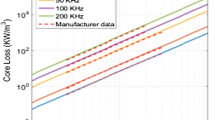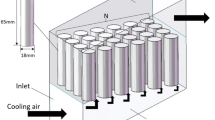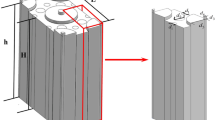Abstract
Owing to an increase in the demand for bidirectional applications such as battery energy storage systems (BESS), isolated bidirectional converters have become more popular. However, conventional transformer design methods such as the area product and core geometrical coefficient methods, consider only one operating point. Thus, these do not always guarantee high efficiency if there are any changes in the operation point of the converter. Accordingly, this paper proposes a multiobjective optimized transformer design algorithm that considers the overall energy loss of the bidirectional operation of the converter. The proposed algorithm adopts a nondominated sorting genetic algorithm-II (NSGA-II) effective core cross-sectional area and turn ratios as main variables. A 20W prototype converter with a transformer for 20-series lithium-ion cell balancing purposes has been built for verification. The results show that the proposed algorithm dissipates lower power loss during the charge and discharge mode of operations with a smaller volume than the conventional method.















Similar content being viewed by others
Data availability
Data are available on request from the authorities.
References
Tran, V.T., Islam, M.R., Muttaqi, K.M., Sutanto, D.: An efficient energy management approach for a solar-powered EV battery charging facility to support distribution grids. IEEE Trans. Ind. Appl. 55(6), 6517–6526 (2019)
Boulanger, A.G., Chu, A.C., Maxx, S., Waltz, D.L.: Vehicle electrification: status and issues. Proc. IEEE 99(6), 1116–1138 (2011)
Sabillón Antúnez, C., Franco, J.F., Rider, M.J., Romero, R.: A new methodology for the optimal charging coordination of electric vehicles considering vehicle-to-grid technology. IEEE Trans. Sustain Energy. 7(2), 596–607 (2016)
Fan, H., Li, H.: High-frequency transformer isolated bidirectional DC–DC converter modules with high efficiency over wide load range for 20 kVA solid-state transformer. IEEE Trans. Power Electron. 26(12), 3599–3608 (2011)
Mohan, N., Undeland, T.M., Robbins, W.P.: Power Electronics: Converters, Applications, and Design, 3rd edn. John Wiley and Sons (2002)
Erickson, R.W., Maksimovic, D.: Fundamentals of Power Electronics. Kluwer, Norwell (2001)
Nijende, H., Frohleke, N., Bocker, J.: Optimized size design of integrated magnetic components using area product approach. 2005 European Conference on Power Electronics and Applications, Dresden, Germany, 10, (2005)
Wu, H.H., Gilchrist, A., Sealy, K.D., Bronson, D.: A high efficiency 5 kW inductive charger for EVS using dual side control. IEEE Trans. Ind. Inf. 8(3), 585–595 (2012)
Ta, L.A.D., Dao, N.D., Lee, D.-C.: High-efficiency hybrid LLC resonant converter for on-board chargers of plug-in electric vehicles. IEEE Trans. Power Electron. 35(8), 8324–8334 (2020)
Zhao, B., Song, Q., Liu, W., Sun, Y.: A synthetic discrete design methodology of high-frequency isolated bidirectional DC/DC converter for grid-connected battery energy storage system using advanced components. IEEE Trans. Ind. Electron. 61(10), 5402–5410 (2014)
Kim, H.-S., Ryu, M.-H., Baek, J.-W., Jung, J.-H.: High-efficiency isolated bidirectional AC–DC converter for a DC distribution system. IEEE Trans. Power Electron. 28(4), 1642–1654 (2013)
Wai, R.-J., Duan, R.-Y.: High-efficiency bidirectional converter for power sources with great voltage diversity. IEEE Trans. Power Electron. 22(5), 1986–1996 (2007)
La, P.-H., Choi, S.-J.: Direct cell-to-cell equalizer for series battery string using switch-matrix single-capacitor equalizer and optimal pairing algorithm. IEEE Trans. Power Electron. 37(7), 8625–8639 (2022)
Nguyen, N.A., La, P.H., Choi, S.J.: Coordinated operation algorithm of pack-chargers and cell-equalizers for SOC adjustment in second-life batteries. J. Power Electron 22, 105–115 (2022)
McLyman, C.W.T.: Transformer and Inductor Design Handbook, 4th edn. CRC Press (2011)
De Nardo, A., Di Capua, G., Femia, N.: Transformer design for isolated switching converters based on geometric form factors of magnetic cores. IEEE Trans. Ind. Electron. 60(6), 2158–2166 (2013)
Deb, K., Pratap, A., Agarwal, S., Meyarivan, T.: A fast and elitist multiobjective genetic algorithm: NSGA-II. IEEE Trans. Evol. Comput.Evol. Comput. 6(2), 182–197 (2002)
Venkatachalam, K., Sullivan, C.R., Abdallah, T., Tacca, H.: Accurate prediction of ferrite core loss with nonsinusoidal waveforms using only Steinmetz parameters. Proc. IEEE Workshop Comput. Power Electron. 2, 36–41 (2002)
Allmeling, J., Hammer, W., Schönberger, J.: Transient simulation of magnetic circuits using the permeance-capacitance analogy. 2012 IEEE 13th Workshop on Control and Modeling for Power Electronics (COMPEL), 1–6, (2012)
Luo, M., Dujic, D., Allmeling, J.: Modeling frequency independent hysteresis effects of ferrite core materials using permeance-capacitance analogy for system-level circuit simulations. IEEE Trans. Power Electron. 33(12), 10055–10070 (2018)
Acknowledgements
This work was supported by the Technology Development Program (S3327193) funded by the Ministry of SMEs and Startups (MSS, Korea.) and "Regional Innovation Strategy (RIS)" through the National Research Foundation of Korea (NRF) funded by the Ministry of Education (MOE) (2021RIS-003).
Funding
This work was funded by Ministry of SMEs and Startups (Grant no. S3327193), Ministry of Education (Grant no. 2021RIS-003) by Sung-** Choi.
Author information
Authors and Affiliations
Corresponding author
Rights and permissions
Springer Nature or its licensor (e.g. a society or other partner) holds exclusive rights to this article under a publishing agreement with the author(s) or other rightsholder(s); author self-archiving of the accepted manuscript version of this article is solely governed by the terms of such publishing agreement and applicable law.
About this article
Cite this article
Im, TY., Nguyen, NA. & Choi, SJ. Multiobjective design optimization of transformers for battery cell balancing converters considering bidirectional power flow. J. Power Electron. 23, 1798–1807 (2023). https://doi.org/10.1007/s43236-023-00705-0
Received:
Revised:
Accepted:
Published:
Issue Date:
DOI: https://doi.org/10.1007/s43236-023-00705-0




